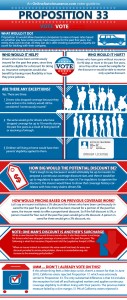
What would Proposition 33 do?
Proposition 33 would allow California car insurance companies to raise or lower your rates or determine your eligibility for coverage based on how consistently you’ve had insurance over the course of the past five years. Currently, they can’t do that. The only way your coverage history can affect your rates is a company can give you a loyalty discount for staying with them.
Who would it help?
Proposition 33 could help drivers who have been continuously insured for the past five years, since they would be eligible for a discount for doing so if the insurer decided to offer such a discount. Insurance companies would also benefit by having more flexibility in how they can price policies.
Who would it hurt?
It could hurt drivers who have gone without insurance for 90 days or more in the past five years, since they either would be ineligible for the discount or would be able to receive only a partial discount.
Are there any exceptions?
Yes. There are three. Insurers would not be able to raise rates because of a lapse in coverage if the lapse was due to military service or if it was for 18 months or less and the result of being laid off. Also, children living at home would be able to have their parents’ eligibility applied to them, since the only reason they didn’t have coverage before was the fact that they were too young to drive.
How big would the potential discount be?
Supporters of the proposition emphasize the fact that its passage could mean a new type of auto insurance discount for California consumers, and that’s true. But it would be up to each individual insurer to determine if it wanted to introduce coverage history into its pricing equation. If they did, it would then be up to each individual insurer to propose its own continuous-coverage discount size. Then, it would be up to regulators to approve or reject each insurer’s request.
Note: One man’s discount is another’s surcharge
While a new discount for insured drivers sounds nice, it also likely means a surcharge for drivers who have dropped coverage for more than 90 days at some point in the past five years. The following is what the state Insurance Department told the Legislative Analyst’s Office:
“When an insurer intends to maintain the same overall rate level, for every new discount provided to certain policyholders, there is a counterbalancing rate increase to the remaining policyholders.”
How would pricing based on previous coverage work?
Let’s say a California insurer institutes a 5 percent discount for drivers who have been continuously insured for the past five years. If a driver has been insured for a portion of the past five years, the insurer needs to offer a proportional discount. So if the full discount is 5 percent, a person insured for four out of the past five years would get a 4 percent discount. A person insured for three would get a 3 percent discount, etc.
Didn’t I already vote on this?
If this whole thing feels a little déjà vu-ish, there’s a reason for that. In June 2010, California voters rejected Proposition 17, which was extremely similar to Proposition 33. The only substantial difference is that 33 includes an exception for laid-off and furloughed workers and applies continuous coverage eligibility to children living with their parents. The previous ballot measure failed by a slim margin; 51.9% of California voters rejected it.